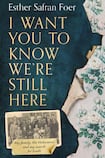
Flip through Esther Safran Foer’s first book, I Want You to Know We’re Still Here, and you’ll find photos. Recent photos, old photos. Children, adults, elderly people. A wedding. A gravestone. A couple, out for a stroll with a baby in a pram, watchtowers, run-down barracks, and a barbed wire fence in the background.
None of these photos is annotated.
“How will I know who these people are?” her grandchild, Sadie, asks one day, looking at the boxes of photos in Esther’s office. The question haunts her. She hasn’t bothered to identify them because she knows who they are. “Sadie’s query,” she says, “made me want to cast aside all other obligations and tend to my vast messy archive. In those crammed boxes, most of what is known of my family’s past resides.”
I Want You to Know We’re Still Here is a memoir about tending to that “vast messy archive” of family past – annotating those photos. There are relatives who died in the Holocaust with no “direct descendants to tell their stories”. But there are others, too, such as her cousin Mark, who died in 1949, aged four, after a routine tonsillectomy. The nooks and crannies that don’t fit a historical narrative are important. The book is steeped in history but, crucially, not concerned with history. It is concerned with family, with memory. This, as they say, is personal.
Safran Foer, by the way, is the “Safran Foer” you were thinking of. Esther’s three sons Franklin, Jonathan and Joshua are all best-selling authors. The most well-known of the three is perhaps Jonathan, author of Extremely Loud and Incredibly Close and Here I Am, among others. His work dovetails interestingly with this book.
The first photo we encounter is of Esther holding up another photo. It contains four people: Esther’s father, an older man, and two women – “the people who my mother thought had hidden him in their house for some part of the war”. In 1998, Esther gave Jonathan 40 copies of this to take with him to Ukraine, where he was hoping to do research for his thesis. He planned to visit the shtetl (Jewish settlement), Trochenbrod, where Esther thought her father had come from, and find the people in the photo.
“Jonathan found nothing.”
This stark line mirrors a recurring theme throughout: the “presence of absence”. “How do I remember when I have nothing to remember?”
Jonathan wrote a story. Everything is Illuminated, his first novel, was based on his journey and the few details he knew of his family history.
But the strange thing was that “fiction mysteriously generated facts”.
Though Jonathan got many details “wrong” about Trochenbrod (can fiction get things wrong?), his imagined shtetl helped to put the real one on the map. The book had a large reach, and evoked memories in some readers. Remembering, this book seems to tell us, even if you remember wrong – even if your memory is only a story – can bring truth to light.
The mess of history
I Want You To Know We’re Still Here tracks that same journey to Ukraine, this time taken by Esther. The discovery that she had a half-sister, killed during the war, furthers her mission. “Of the person closest to me killed in the Holocaust, my half sibling, I had not one detail, not a name, not a picture – not one piece of memory.” In effect, this book is a search for the tiniest of things among the large mess of history: a name.
It’s a noble search, and makes for a moving book. Much of the narrative is sad. Death, silence, emptiness haunt the work. There are things that may never be known. But the telling is unique and interesting. The book succeeds in putting names (or more precisely, stories) to things that exist only as artefacts, and inversely putting physicality to things that exist only as story.
The delineation between history and memory is a significant one, and gives an interesting angle to the narrative. “History is public. Memory is personal. It is about stories and select experiences. History is the end of something. Memory is the beginning of something.”
The book closes with an end – the death of Esther’s mother – and two beginnings: two births of two new grandchildren. Grief is tinged with hope. At the funeral, there is gratitude for the long life Esther’s mother led: “She did it. She survived, and survived with dignity and grace.”
The last photo is a recent one: of a large, happy Safran Foer gathering. It depicts generations of “survivors and survivors of survivors, storytellers and memory keepers”. A family of writers, putting words to the silence. As one of the grandchildren quipped: “take that, Hitler!”










